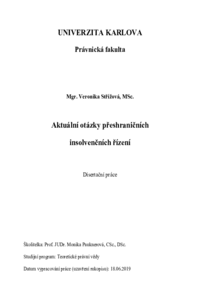Aktuální otázky přeshraničních insolvenčních řízení
Current issues of cross-border insolvency proceedings
dizertační práce (OBHÁJENO)

Zobrazit/
Trvalý odkaz
http://hdl.handle.net/20.500.11956/121569Identifikátory
SIS: 168576
Kolekce
- Kvalifikační práce [14741]
Autor
Vedoucí práce
Oponent práce
Rozehnal, Aleš
Brodec, Jan
Fakulta / součást
Právnická fakulta
Obor
Teoretické právní vědy - Mezinárodní právo soukromé a právo mezinárodního obchodu
Katedra / ústav / klinika
Katedra obchodního práva
Datum obhajoby
9. 6. 2020
Nakladatel
Univerzita Karlova, Právnická fakultaJazyk
Čeština
Známka
Prospěl/a
Klíčová slova (česky)
Evropské insolvenční nařízení, přeshraniční insolvenční řízení, korporátní restrukturalizace, COMI, úpadek členů skupiny společností, spolupráce a koordinace, politika "druhé šance"Klíčová slova (anglicky)
European Insolvency Regulation, EIR Recast, cross-border insolvency, corporate restructuring, corporate bankruptcy, COMI, bankruptcy of groups of companies, cooperation and coordination, 2nd chance frameworkCílem této disertační práce je zanalyzovat současný stav evropského insolvenčního práva, a za pomoci národní i evropské judikatury vytvořit přehled praktických problémů, kterým insolvenční soudy, dlužníci, věřitelé a insolvenční správci čelí napříč Evropou v rámci přeshraničních insolvenčních řízeních. V jádru této problematiky stojí evropské insolvenční nařízení (Nařízení evropského parlamentu a rady (EU) 2015/848), které bylo přijato v roce 2015 a je účinné v členských státech od června 2017. Vzhledem k tomu, že toto nařízení bylo vytvořeno jako přepracovaná verze svého předchůdce, tj. původního insolvenčního nařízení z roku 2000, které bylo v účinnosti od roku 2002 do 2017, přirozeně se výzkum v této práci orientuje na porovnání obou těchto právních předpisů. Práce zejména míří na zhodnocení toho, zda se přepracované nařízení dokázalo vypořádat s nepřesnostmi v textu původního nařízení, které vedly k protichůdným interpretacím, v jejichž důsledku bylo k Soudnímu dvoru Evropské Unie podáno značné množství předběžných otázek. Kromě rozboru klasických institutů mezinárodního práva soukromého, jako je působnost, soudní příslušnost, rozhodné právo nebo otázka uznání a výkonu podle nařízení, se tato práce zaměřuje také na témata, která jsou zcela specifická pro oblast insolvencí a v základu se zcela...
The aim of this PhD thesis is to analyse the current status of European insolvency law and with the help of both national and European judicial decisions put together an overview of practical obstacles that insolvency courts, debtors, creditors and insolvency trustees across Europe are facing when dealing with cross-border insolvencies. At the very core of this topic stands the European Insolvency Regulation ("EIR") which was adopted in 2015 and is effective within the member states as of June 2017. Since this regulation was put together as a recast of its predecessor, i.e. the original insolvency regulation adopted in 2000 and effective as of 2002, naturally this research is oriented at comparing the two legislative acts and mainly assessing whether or not the recast EIR managed to overcome some of the inconsistencies in the wording of the original EIR, often resulting in conflicting interpretations and a great deal of preliminary rulings filed with the Court of Justice of the EU. Apart from looking into good old instruments of private international law such as the scope, the jurisdiction, the choice of law and the recognition and enforcement rules governed by the EIR, this thesis also focuses on topics that are very bankruptcy-specific and dissimilar to anything we know from other fields of law....
